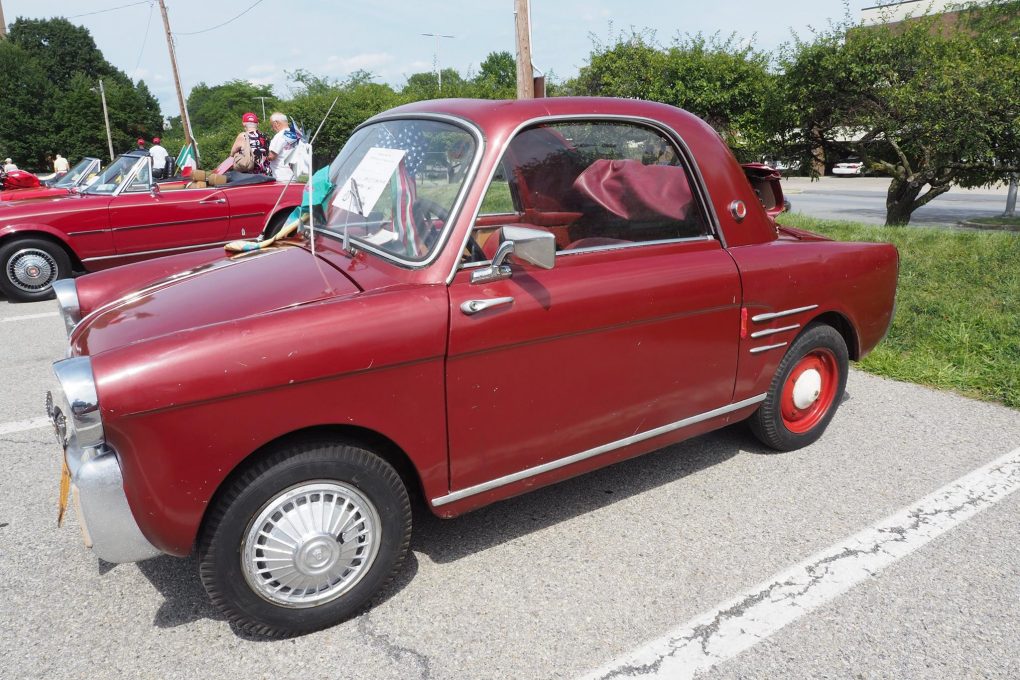After a century, the classic Italian cars have returned to the Mid-Hudson Valley. Of course they never really left, as the high artistry of quality Italian automobiles has long been appreciated and adored by owners, collectors, and car clubs along the beautiful and famous river. Yet the holding of the Second Annual Festival of Fine Italian Cars at the Italian Center in Poughkeepsie, New York, on Sunday, August 6th had a special symbolic resonance, as the hundredth anniversary of the closing of FIAT’s legendary assembly plant located in the city is approaching. “I feel it is a tremendous event not just for the Center, but for the whole community, a celebration of our heritage,” says Ernie Bruno, the jovial president of the institution which has been the heart of Italian-American life in Poughkeepsie since its founding in 1928. “The story of the FIAT plant is a big part of local lore, and to be displaying these remarkable creations of the Italian motor vehicle industry a stone’s throw from where they were once built is something truly unique.”

FIAT, which was founded in Turin in 1899, opened its American plant in Poughkeepsie in 1910, as a way of avoiding the crushing 45% import duty on all foreign-made cars then imposed by the United States. The 4 and 6 cylinder engine vehicles were identical in design to those manufactured in Italy, but the reduced price made all the difference in terms of sales. While a 1913 FIAT 56 made here cost about $ 6,000, the equivalent of $ 125,000 today, that was still an enormous savings, and the carefully and individually assembled autos were quite popular with luxury buyers. Yet the thriving venture was ironically doomed by the American entry into World War I, which, though it brought the two nations into alliance, made the import of parts prohibitively expensive and dangerous due to German unlimited submarine warfare, and the plant closed in 1918. However there were no impediments to the display of Italian creativity at this year’s festival, which was co-sponsored by the Pirandello Institute, a cultural center established in Poughkeepsie last year by Vita Mesnick. Under the watchful gaze of a statue of Christopher Columbus raised to mark the 500th anniversary of the Discovery of America in 1992, the parking lot in front of the Italian Center’s gracious redbrick Victorian mansion was thronged with FIATs, Ferraris, Alfa Romeos and Maseratis, ranging in age from the 1950s to today.

And a diverse display it was. A 1970 Alfa Romeo Giulia Super, medium sized yet stately with its deep purple color and upright carriage, bore the vivid green serpent emblem of the Visconti dukes of Milan on either side of its rear window. Nearby a fire engine red 1974 Ferrari Dino 246 GT stretched long, sleek, and low. And a tiny brown 1959 FIAT Bianchi somehow managed to pack four seats into its diminutive frame. FIAT, Ferrari, and Alfa Romeo Spider convertibles manufactured from 1976 to 2007 vied with each other to assert their claim to that enduring brand name. As he wandered among the varied jewels of Italian automotive imagination, Mark Searle, the president of the Hudson Valley Chapter of the (FCA), explained his lifelong love of that car. “When I was 14 years old, I wrote a letter to Enzo Ferrari, asking him if he had any extra cars lying about, and if so, could he give me one?” he recalled with a smile. “I never got an answer, but here I am with my Ferrari.” After several hours basking in the cars and the sun, the gathering entered the Italian Center’s mansion to hear Dr. Vincent Beltrani of the FCA deliver a slide lecture on “The Passion For The Automobile” while dining on a buffet that seemed as fine and varied as the vehicles and history he discussed. Among other interesting anecdotes, he told the story of how Ferruccio Lamborghini, who had been a manufacturer of farming machines, was so dissatisfied with a Ferrari he bought that he vowed to go into car production himself in 1963. However Dr. Beltrani, stating the obvious, said that he himself felt no such emotions when he toured the Museo Enzo Ferrari in Modena, and recounted his visit to architect Corrado Lopresto’s large collection of rare vintage cars, prototypes, and unique pieces located in a warehouse in Milan. “His passion for cars is poetic,” he mused. “And going there, you totally understand it – You can stare at those cars for hours, and not be sated.”












